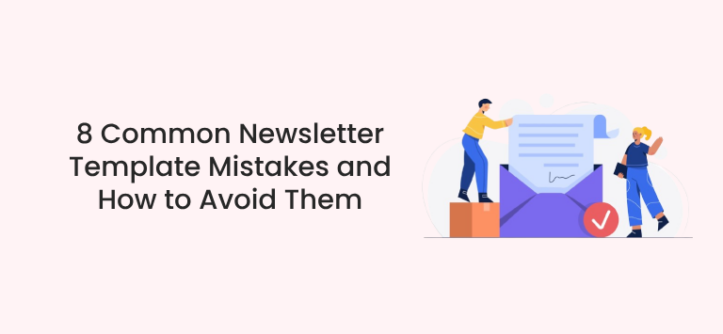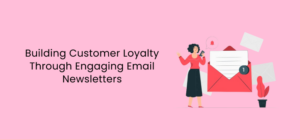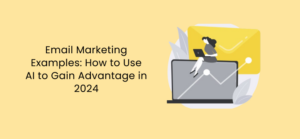Email is one of the most powerful communication tools in the world of digital marketing- but only if you use it effectively. Newsletters are valuable additions to any email marketing strategy- getting consumer attention directly and giving you a great opportunity to promote and educate people on your business, product, or services.
When done well, newsletters provide an excellent return on investment and an easy way to increase customer engagement. Unfortunately, there are a few common mistakes made that can ruin the effect. Using a template streamlines newsletter creation and improves consistency- ultimately making your communications more professional and appealing to your audience.
Building a great template starts with knowing what to do- and what not to do. Here are some of the newsletter template mistakes seen in modern marketing strategies and some helpful tips on how to avoid them.
Design Mistakes
Designing your newsletter template is the first step- long before you start thinking about content. A solid design lends itself to newsletters of all kinds, and you can always fall back on them when it comes time to send out your next communication.
We have discussed the three most common missteps in newsletter design below to help guide you down the right path for your templates.
1 – Ignoring Mobile Optimization
The majority of email users who check their email more than once per day do so on a mobile device. These days, people are rarely far from their phones – and it pays to remember this when you are creating an email marketing strategy.
Newsletters are no exception. Without proper mobile optimization, you risk missing out on a significant audience and alienating the people who open your emails on a phone or tablet. Overcomplicated newsletters with image errors, formatting issues, and other compatibility problems turn off readers immediately. As a result, they don’t actually look at the content properly.
Image Source – Jeni’s
So, how can you avoid this mistake? The first thing to remember is that mobile-friendly designs are simple- so they translate well on a small screen. Rather than trying to squeeze a web page’s worth of content into a small newsletter, think about an eye-catching and easily digestible design that gets your point across but doesn’t look or feel convoluted.
2 – Forgetting About Branding
Just because the email comes from your business account doesn’t mean you can assume people will recognize and remember your brand. Branding is essential for digital marketing. You should never leave it out of your newsletters.
A mistake many businesses make is to strip newsletters bare of all branding- leaving them looking generic, uninspiring, and sometimes untrustworthy. You want your audience to know who you are at first glance. Good branding is the way to do that.
Some of the top things to consider are:
- Your brand colors: Pick a color scheme that fits your brand and use it in your newsletter templates.
- Pick a font and be consistent. Changing your font style, size, and color can be confusing and distract from the information.
- Choice of images and other visuals: Generic visuals won’t make your brand stand out- something you need to do if you want your newsletters and general email marketing campaign to be successful. Only use visuals that add value and are specific to your brand.
- Logo placement: Failing to put thought into where you put your logo is detrimental. Logos should be at the top of your newsletter so people can see it immediately. It can be centered or to the left- whatever looks better for the shape of your logo. You can also put it again at the end if you have space.
3 – Information Overload
Newsletters are not blogs. They are bite-sized communications highlighting specific, targeted information. Overloading a newsletter with scrolls of content will likely switch off your readers very quickly, and they probably won’t get to the point you are trying to get across. Too much content also makes a newsletter look cramped and cluttered.
You want your newsletter to be scannable- a.k.a. people can get a decent overview with a quick gloss through. To achieve this, you should have a clear heading hierarchy, a good amount of white space (breaks between copy and visuals that give the reader a moment to digest what came before and prepare for what comes next), and brief, concise text that adds value.
Content Mistakes
Once you have the basic design nailed down, you can start to think about what goes in it. We already touched on some content-related mistakes, but let’s elaborate on the details.
4 – Lack of a Clear Call to Action (CTA)
A call to action directs the reader to do something with the information they have just received. It could be to contact your business, to follow a link to purchase a product, or something else. Put simply, it sums up the point of the communication and tells the consumer what to do next.
Without a clear CTA, even the best newsletter won’t convert leads to sales or have the desired effect for your business. If you don’t have one, people might find the whole thing a bit pointless. A weak call to action isn’t much better, as it won’t drive people forward on their buyer journey.
You need clear instructions that leave no doubt about the next steps- and make sure any links or buttons are well-designed, easily visible, and actually work. Otherwise, they might be overlooked or drive your customer away for good.
5 – Generic and Uninspiring Content
Nobody wants to waste valuable time reading something generic or boring. It won’t do you any favors to send out newsletters that don’t interest or inspire your audience. Instead, the content should engage the reader, provide relevant information, and be interesting enough to hold their attention.

Image Source – Chamberlain Coffee
Generic content templates with no personalization or personality don’t inspire, engage, or interest people- and frankly, can come across as a brand not putting in much effort. Sending out dull or irrelevant content can irritate your consumers and secure your newsletters a season ticket to the junk folder.
Before finalizing content, make sure it checks these boxes.
- It is captivating and relevant to your target audience.
- It is true to your brand personality.
- It is engaging and easy to digest.
- It holds attention from start to finish.
6 – Forgetting About Accessibility
You have to cater to all your readers- including those with disabilities, visual impairments, or who use assistive technology. Email accessibility is all about smart color choices, readability, and semantic elements.
Some techniques you can use to improve newsletter accessibility include:
- Larger fonts in a readable typeface
- Adding alt text to images
- Using p and h tags
- Sticking to high color contrasts
- Avoiding gifs, flashing images, and other potentially harmful visuals
- Leaving space between blocks of text (and keeping the blocks short)
If you forget about accessibility, you risk alienating some consumers.
Sending Mistakes
How you send email newsletters also matters. Your newsletter templates are only as effective as the communication strategies you use. Here are some important considerations.
7 – Inconsistent Sending Schedule
Consistency is key in communication. It helps build trust, predictability, and brand loyalty. A well-thought-out sending schedule helps ensure you remain relevant and visible without irritating your audience.
Erratic email patterns show a lack of organization. Bombarding your consumers will likely annoy them. Failing to send enough communication can see you slip off the radar and seem untrustworthy. A consistent, well-balanced sending schedule builds trust and helps people stay engaged with your business.
8 – Neglecting Segmentation
Segmentation in email marketing is organizing recipients into targeted groups- so you can send relevant information to the right people. It can be based on geographical locations, consumer behavior, demographics, or previous activity and interactions. These are just some examples.
Without segmentation, you always send everyone everything- even if it isn’t right for them. This feels generic and impersonal. In contrast, using segmentation well ensures a more personal approach to email marketing- and takes your audience’s preferences into account.
Targeted communication benefits businesses by helping them appear more in tune with the needs and wants of their customers.
Conclusion
To sum up, people most often make mistakes in their newsletter templates in the design, content, and sending habits. Being generic and irrelevant, forgetting to properly adapt your communications for readers’ benefit, and failing to implement an effective communication schedule are amongst the more detrimental errors.
By creating professional, engaging, and targeted email newsletter templates, you give your business the best chance of success- and keep your consumers happy in the process.




